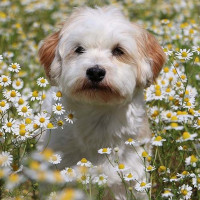Appearance of the Schnese
|
| Your Schnese hybrid is a mix of Miniature Schnauzer and Havanese Bichon and, as such, can take on the appearance characteristics of either or both parent breeds. The Schnese has been described as measuring between 25.5 and 33 centimeters and weighing between 3 and 7 kilos. If the Schnauzer parent is dominant in the biological mix, it may have bushy eyebrows and a beard, and its coat is probably soft, fine and straight, the most common colors being black, brown, silver, gray and white. Puppies are said to have black and brown coloring, which turns gray or silver as they age. His eyes are dark and small, almond-shaped or sunken, his nose is black and he has a scissor bite. Its ears are floppy and its tail can vary in length. |
Temperament of the Schnese
|
| Your hybrid Schnese is a mix of Miniature Schnauzer and Havanese Bichon and, as such, may inherit temperament traits from one or both of its parent breeds. Breeders and owners have described its temperament as affectionate, loving, friendly and intuitive to the needs of its human family. It's also fun-loving, playful and eager to please, making it easier to train than a variety of other breeds. You'll probably find him lively, loyal, energetic and intelligent, and more than willing to bond with you in everything you do. This is not, however, a dog that will do well if left outside or alone for long periods, suffering from the separation anxiety that is common to Velcro dogs. You can expect to have to socialize her appropriately from an early age to ensure that she gets on well with children, strangers and other animals. As she's a small dog, it's also very important to teach your children the proper ways to touch and play with her. He'll probably get on quite well with the other animals in your home, especially if he's been raised with them. Be aware that he has a strong propensity for hunting, which may cause him to go on the prowl when confronted with other small animals. It will probably have some of the Schnauzer's stubbornness in the biological mix, but should otherwise be moderately easy to train. |
Needs and activities of the Schnese
|
| Your Schnese is an active little dog who will need a few daily walks, playtime in the dog park or fenced garden and interactive games of fetch, frisbee and fly ball to manage its energy levels. Obedience and agility training and practice are also good ways to manage his energy and zest for life. So it's important to keep him on a leash when he's outside the house, unfenced yard or similar enclosure. If you're not careful at this stage, you'll find yourself chasing him through brambles and heather, wherever a small animal or an interesting scent leads him. Because of his small size and the fact that he doesn't bark much, he can live very well in an apartment or condominium, provided he is offered appropriate exercise opportunities. He can also live well in a family home, with or without a fenced yard, in an urban or rural environment. It can tolerate both hot and cold climates, provided it has appropriate protection against extreme temperatures. |
Maintenance of the Schnese
|
| Your Schnese hybrid falls into a moderate maintenance category, requiring daily brushing unless its coat is kept short. Although he sheds moderately and you should expect to vacuum frequently, both parents of the breed are considered hypoallergenic. His ears should be checked weekly and cleaned if necessary with a cotton ball and an approved canine ear cleaner. While you're checking his ears, take a look at his toenails, trimming them if necessary, unless they're worn down by his normal physical activity. As with almost every dog breed on the planet, we recommend brushing at least two or three times a week, although daily brushing is optimal. This will help prevent the development of periodontal disease and the tooth loss that goes with it. Its odor level is considered low, as is its drool level. |









 English (United Kingdom)
English (United Kingdom)